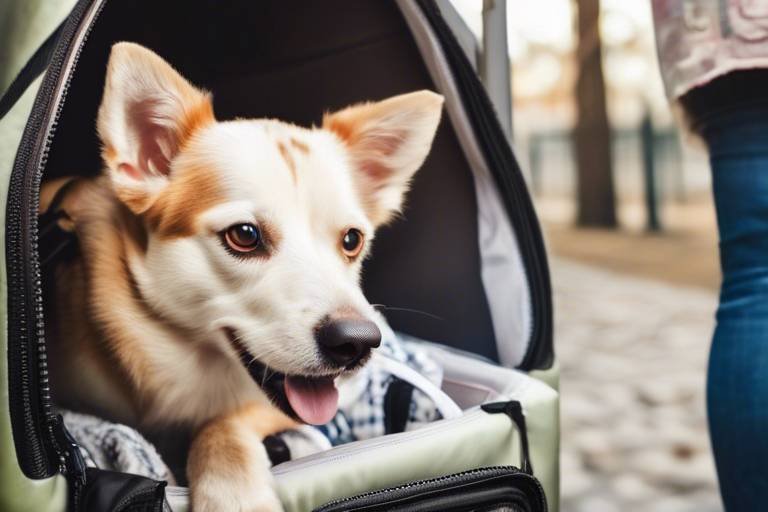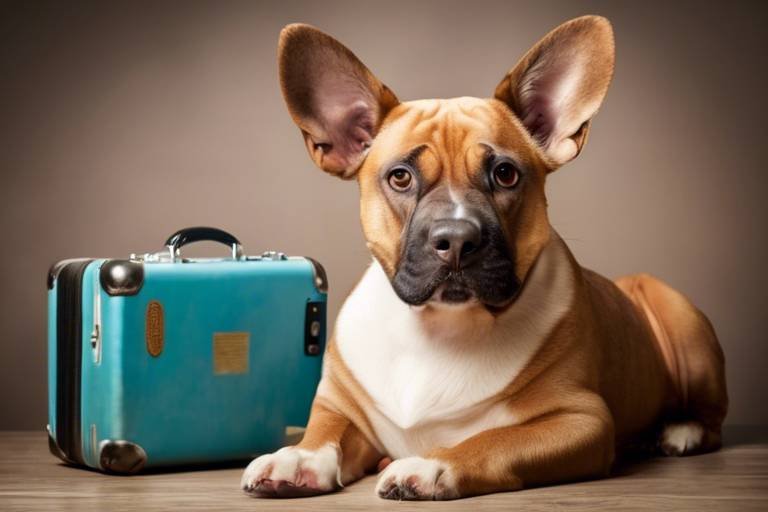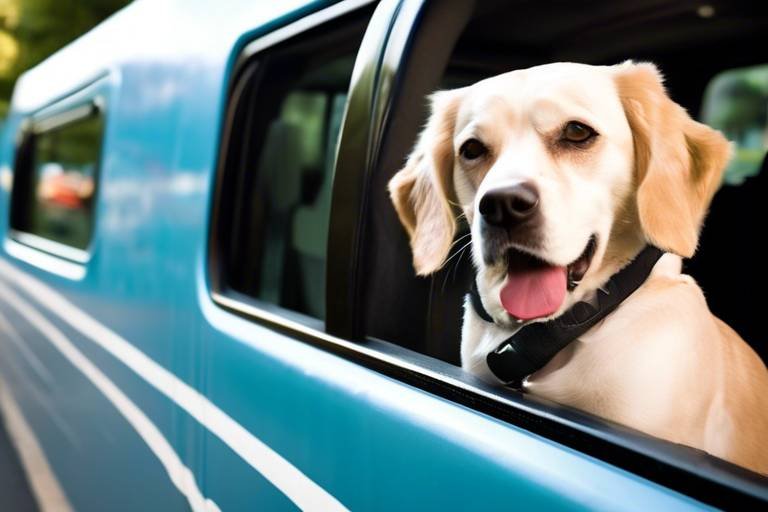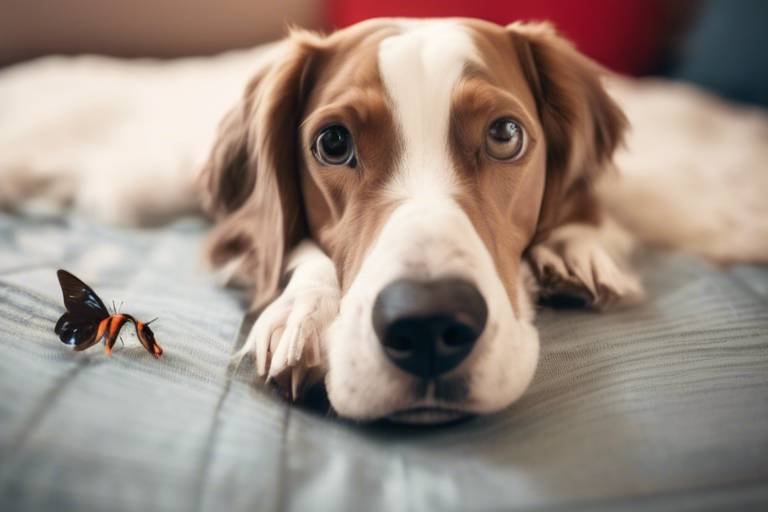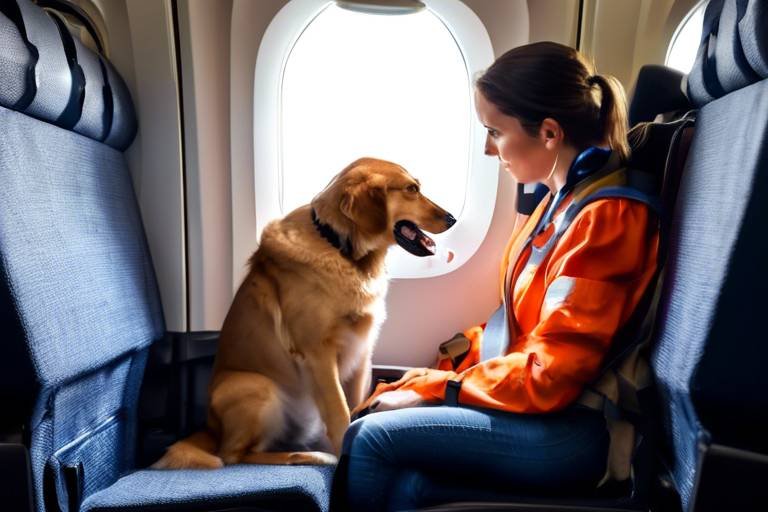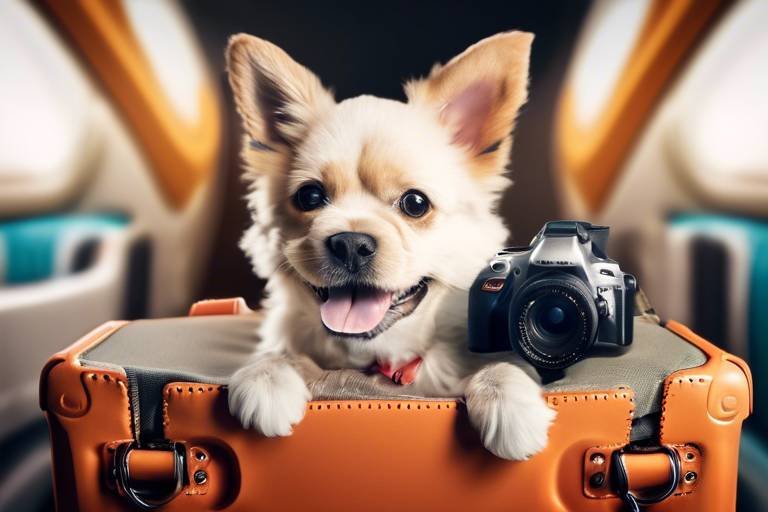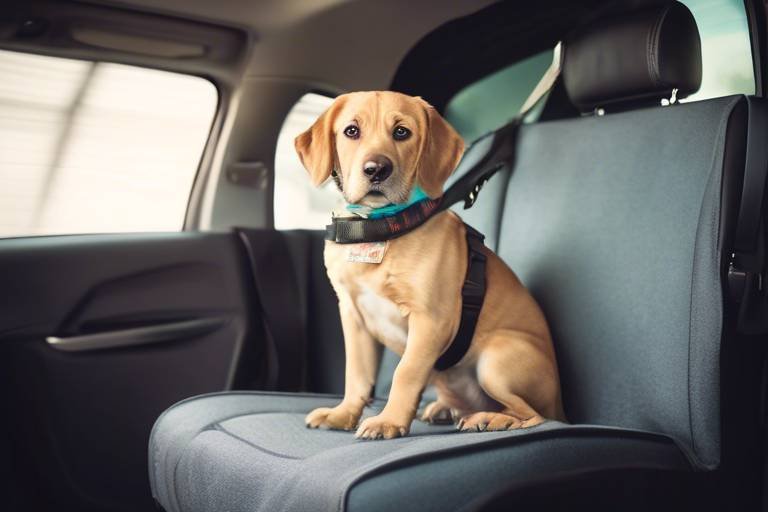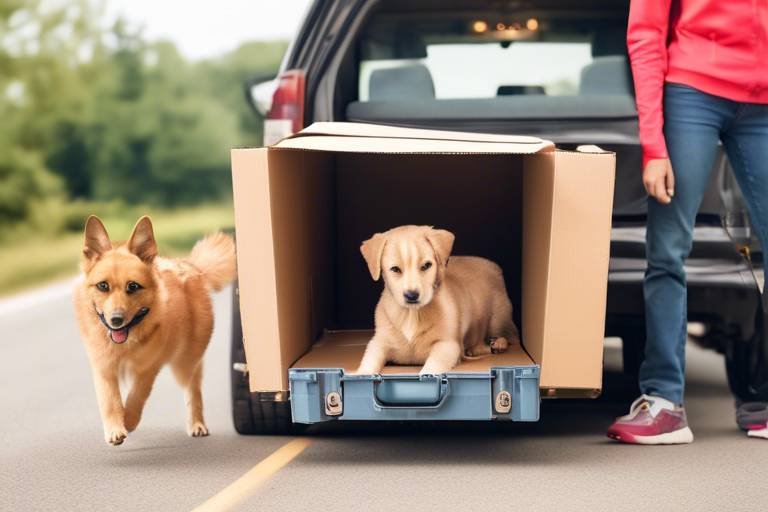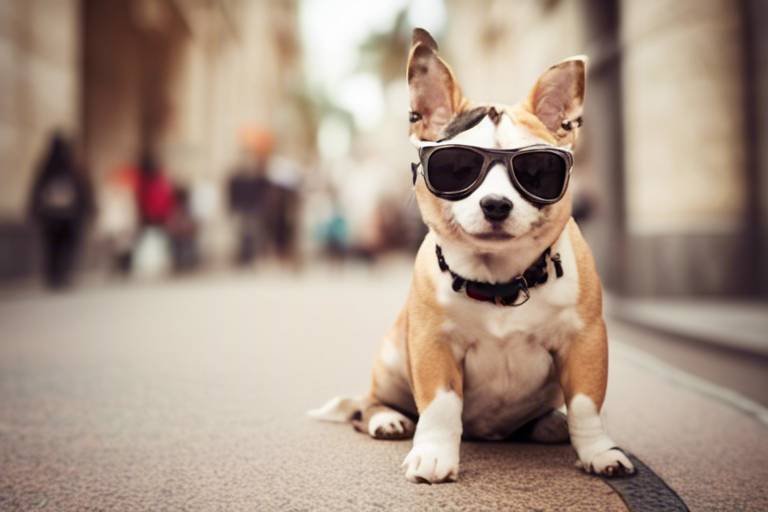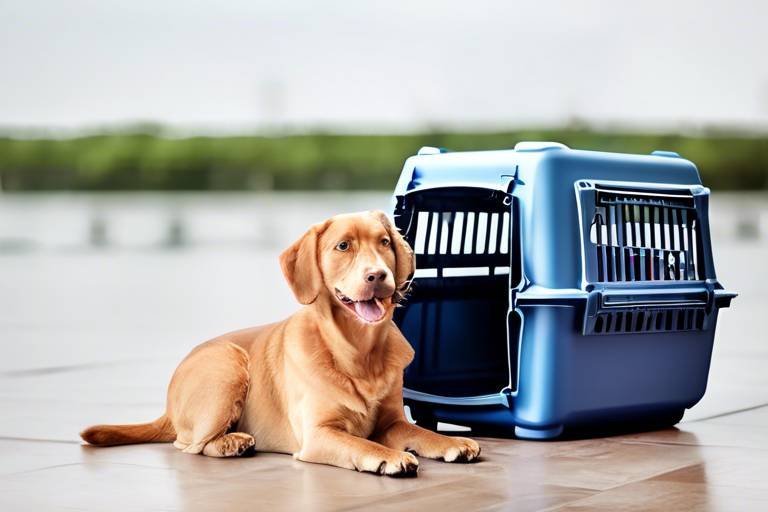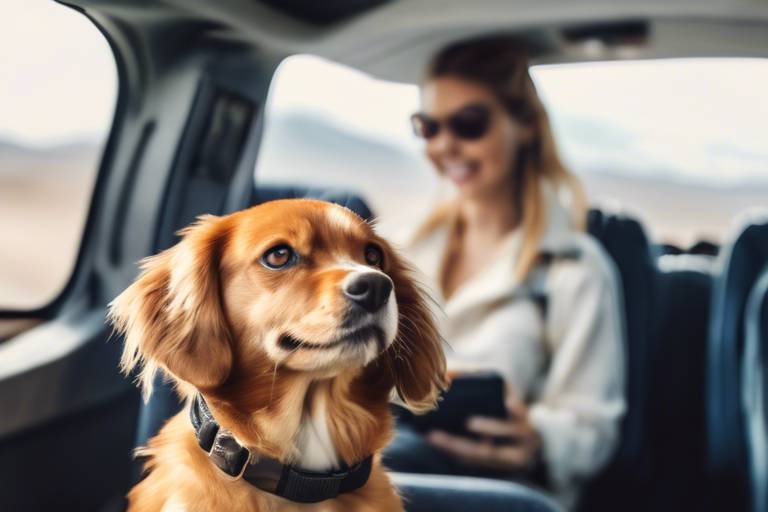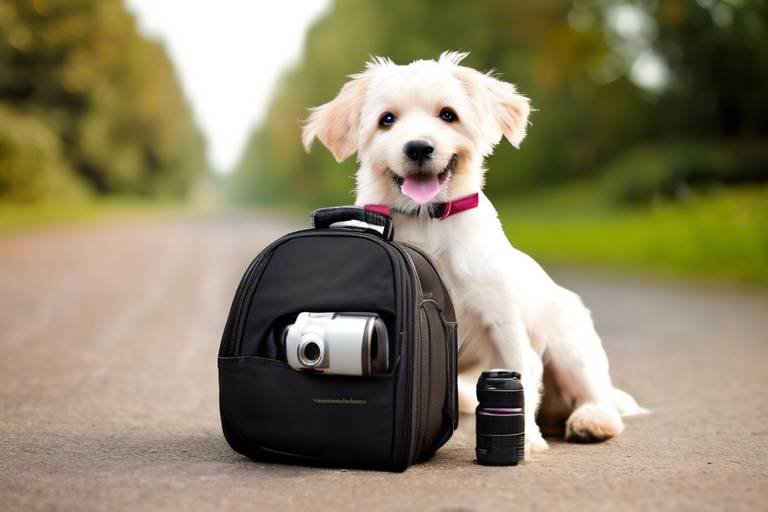How to Create a Pet Travel Checklist
Traveling with your furry friends can be one of the most rewarding experiences, but it also comes with its own set of challenges. To make sure you and your pet have a fantastic time, creating a pet travel checklist is essential. This checklist not only helps you remember all the necessary items but also ensures that your pet’s needs are met throughout the journey. After all, a happy pet means a happy trip, right?
When you think about it, traveling with a pet is a bit like preparing for a mini-expedition. Just as you wouldn't head into the wilderness without the right gear, you shouldn't hit the road with your pet without a well-thought-out plan. So, what should you include in this checklist? Let's dive deeper into the essential components that will make your travel experience smooth and enjoyable.
Every pet has unique requirements, and understanding these needs is crucial for planning a successful trip. Factors like your pet's breed, age, and health can significantly influence what you need to pack. For instance, a young, energetic puppy might require different travel gear compared to a senior cat with health issues. Assessing your pet's specific needs will allow you to tailor your checklist accordingly.
Before you hit the road, it’s vital to gather all necessary documents for your pet. This includes vaccination records, identification tags, and health certificates. Proper documentation ensures a smooth travel experience, especially if you plan to cross state lines or travel internationally.
Keeping your pet's vaccination records updated and accessible is a must. This information is not just a formality; it can be crucial for traveling across state lines or international borders. Additionally, many accommodations and pet-friendly venues will require proof that your pet is up to date on their vaccinations.
A health certificate from your veterinarian may be necessary for travel. This document serves as proof that your pet is healthy and fit for travel, especially for air travel or when crossing state lines. It's a good idea to get this certificate a few days before your trip to avoid any last-minute scrambles.
Ensure your pet wears a collar with an ID tag that includes your contact information. Microchipping is also highly recommended for added security in case your pet gets lost during the trip. Think of it as an insurance policy for your furry friend—better safe than sorry!
Choosing the right gear is essential for your pet's comfort and safety. Here are some must-have supplies:
- Crates or Carriers: A sturdy and comfortable crate or carrier is vital for keeping your pet safe during travel.
- Leashes and Harnesses: Make sure you have a reliable leash and harness to keep your pet secure during pit stops.
- Travel Bowls: Collapsible travel bowls are perfect for feeding and hydrating your pet on the go.
Having the right travel gear not only makes the journey easier but also ensures that your pet feels secure and comfortable throughout the trip.
Acclimating your pet to travel can significantly reduce anxiety. Start by taking short trips with your pet to help them adapt to being in a vehicle or carrier. Gradually increasing the duration of these trips will help your pet become more comfortable with longer journeys.
Make your pet's travel area cozy and secure. This includes using familiar blankets, toys, and a comfortable crate. Just like we feel more at ease in our own beds, your pet will appreciate having familiar items around them during the journey.
Safety should always be a priority when traveling with pets. Always secure your pet in the car using a crate or pet seatbelt to prevent distractions while driving. Recognizing signs of stress in your pet can help you address their needs promptly, ensuring a more pleasant travel experience for both of you.
Understanding your pet's stress signals can help you soothe them during travel. Common signs of anxiety include whining, pacing, or excessive drooling. If you notice these behaviors, try to comfort your pet with gentle words or a familiar toy to help ease their nerves.
Not all accommodations welcome pets, so it’s essential to do your research before booking your stay. Always check the pet policies of your chosen accommodation. Some places may have size restrictions, additional fees, or specific rules for pets. When making reservations, inform the hotel of your pet's presence to ensure a smooth check-in process.
Before booking, always check the pet policies of your chosen accommodation. Some hotels may charge additional fees for pets or have specific rules regarding where pets can go. Knowing these details in advance can save you a lot of hassle later on.
When making reservations, make sure to inform the hotel about your pet. This allows the staff to prepare for your arrival and ensures a smoother check-in process. Plus, it can help you avoid any surprises when you arrive.
Q: What documents do I need to travel with my pet?
A: You typically need vaccination records, a health certificate from your vet, and identification tags.
Q: How can I keep my pet calm during travel?
A: Acclimate your pet to travel with short trips, create a comfortable space for them, and recognize their stress signals to provide comfort when needed.
Q: Are there specific hotels that allow pets?
A: Yes, many hotels are pet-friendly! Always check their pet policies before booking to ensure a smooth stay for you and your furry friend.

Understanding Your Pet's Needs
When it comes to traveling with your furry friends, understanding their unique needs is paramount. Just like us, pets have individual preferences and requirements that can greatly influence their travel experience. For instance, a large breed dog may need more space and a sturdier crate compared to a small breed that might feel comfortable in a soft carrier. Additionally, factors such as age, health, and even temperament play significant roles in how well your pet will adapt to traveling.
Let’s delve deeper into some of these factors:
- Breed: Different breeds come with varying energy levels and comfort needs. For example, a high-energy breed like a Border Collie may require more frequent breaks during long travels compared to a laid-back Bulldog.
- Age: Puppies and senior pets often require special considerations. Puppies might need frequent bathroom breaks, while older pets may have health issues that require regular monitoring.
- Health Condition: If your pet has any pre-existing health conditions, it’s crucial to consult your veterinarian before traveling. They can provide insights on how to best care for your pet on the road.
- Temperament: Some pets are naturally more anxious than others. If your pet tends to be skittish, consider how you can create a calming environment during travel.
Moreover, it’s essential to think about your pet's daily routine. Maintaining a semblance of their normal schedule can help reduce anxiety. For instance, if your pet is used to a specific feeding time or a daily walk, try to stick to these routines as closely as possible during your travels. Bringing along their favorite toys or blankets can also provide comfort and familiarity.
In addition, consider the environment you’ll be traveling to. Will it be hot or cold? Are there any potential hazards? Understanding these aspects can help you prepare adequately. For example, if you’re heading to a warm climate, ensure you have plenty of water and shade for your pet. Conversely, if it’s colder, think about how to keep them warm during your travels.
Ultimately, the key to a successful travel experience with your pet lies in preparation and understanding. By taking the time to assess your pet’s needs and making the necessary adjustments, you can ensure that both you and your furry companion enjoy a stress-free journey. Remember, a happy pet means a happy trip!

Essential Travel Documents
Before you embark on an adventure with your furry friend, it's crucial to gather all the necessary travel documents. Think of these documents as your pet's passport to a world of fun and exploration. Just like we need our IDs and travel papers, pets also require specific documentation to ensure their safety and well-being during the journey. This not only helps in smooth transitions between locations but also safeguards your pet's health and identity.
One of the most important documents is the vaccination record. Keeping this record updated and easily accessible is vital, especially if you're traveling across state lines or even internationally. Many accommodations and pet-friendly venues will ask for proof of vaccinations, so having this information at your fingertips can save you a lot of hassle. Ensure that your pet's vaccinations, such as rabies and distemper, are current and documented. It’s a good idea to keep a copy of this record in your travel bag, just in case.
Vaccination records serve as a health passport for your pet, showcasing their immunization history. In many cases, these records are not just a formality; they are a requirement. Without them, you might find yourself in a sticky situation at a hotel or a pet-friendly park. To make things easier, consider keeping both digital and physical copies of these records. You can use a simple table to organize the information:
| Vaccine | Date Administered | Next Due Date |
|---|---|---|
| Rabies | 01/15/2023 | 01/15/2024 |
| Distemper | 02/20/2023 | 02/20/2024 |
Next up is the health certificate. This document, usually issued by a veterinarian, certifies that your pet is healthy and fit for travel. It's particularly important if you're flying or crossing state lines. Many airlines and border control agencies require this certificate to ensure that pets are not carrying any contagious diseases. Think of it as your pet's "get out of jail free" card, proving they are in good shape and ready to travel.
Obtaining a health certificate is generally straightforward. Schedule a visit with your veterinarian a few weeks before your trip to give them time to conduct a thorough examination. Once your vet confirms your pet's health, they will provide you with the necessary paperwork. Remember, this certificate often has a validity period, so plan your trip accordingly!
Last but certainly not least, don’t forget about identification tags. Just like you wouldn’t leave home without your ID, your pet should wear a collar with an ID tag that includes your contact information. In the unfortunate event that your pet gets lost, this tag can be a lifesaver. Additionally, consider microchipping your pet for an extra layer of security. It's a simple procedure that can make a world of difference if your pet wanders off in an unfamiliar place.
In summary, having the right travel documents is fundamental to ensuring a smooth trip with your pet. By keeping their vaccination records, health certificates, and identification tags in order, you can focus on what really matters: creating lasting memories with your furry companion. So, before you hit the road, double-check your checklist to ensure you have everything you need for a safe and enjoyable journey!
Q: What should I do if I lose my pet's vaccination records?
A: Contact your veterinarian; they can often provide you with a copy of your pet's vaccination history.
Q: Is a health certificate required for all types of travel?
A: Not always, but it's highly recommended for air travel and crossing state lines.
Q: How can I ensure my pet is comfortable during travel?
A: Familiarize them with their travel gear before the trip and take practice runs to help them adjust.
Vaccination Records
Keeping your pet's updated and easily accessible is crucial for a seamless travel experience. Just like you wouldn't want to leave home without your ID, your furry friend shouldn't travel without proof of their vaccinations. These records serve as a passport for your pet, ensuring they are protected against diseases and can meet the requirements of various travel destinations.
When planning your trip, remember that different states and countries have specific vaccination requirements. For instance, rabies vaccinations are often mandatory, and some places may require proof of other vaccinations as well. It's essential to have these documents on hand, as accommodations and pet-friendly venues may ask for them before allowing your pet inside. Imagine arriving at a beautiful hotel only to be turned away because you forgot your pet's vaccination history—definitely not the kind of surprise you want!
To keep things organized, consider creating a travel folder specifically for your pet's documents. This folder can include:
- Vaccination records
- Health certificates
- Identification tags
Additionally, it's a good idea to take a few digital copies of these documents. Store them on your phone or in a cloud service, so you can access them anytime, anywhere. This way, if you encounter any unexpected issues during your travels, you can quickly provide the necessary proof without any hassle.
In summary, having your pet's vaccination records in order is not just a formality; it's a vital part of ensuring a fun and stress-free travel experience. By being prepared, you can focus on making memories with your furry companion instead of worrying about paperwork.
Q: What vaccinations are typically required for pets when traveling?
A: Commonly required vaccinations include rabies, distemper, and bordetella. However, requirements can vary by location, so always check local regulations before traveling.
Q: How often should I update my pet's vaccination records?
A: Vaccination schedules can differ depending on the vaccine type and your pet's age. Consult your veterinarian to determine the best schedule for your pet.
Q: Can I travel with my pet if they are not fully vaccinated?
A: While it may be possible to travel with an unvaccinated pet, it is not advisable. Unvaccinated pets are at a higher risk of contracting diseases, and you may face restrictions at various destinations.
Health Certificates
When planning to travel with your pet, one of the most important documents you might need is a health certificate. This official document is typically issued by a licensed veterinarian and serves as proof that your furry friend is in good health and free from any contagious diseases. It's especially crucial if you're considering air travel or crossing state lines, as many airlines and states require it. Think of it as your pet's travel passport—without it, your journey could hit a snag.
To obtain a health certificate, you should schedule a visit to your veterinarian. During the examination, the vet will assess your pet's overall health and may perform necessary vaccinations or tests. It’s wise to do this well in advance of your trip, as some certificates have specific validity periods, often ranging from 10 days to a few months, depending on where you're traveling.
In addition to the health certificate itself, you might want to consider the following points:
- Timing: Ensure the health certificate is issued close to your travel date, but still within the valid timeframe required by your destination.
- Documentation: Ask your vet for any additional documents that may be required, such as vaccination records or proof of recent treatments.
- Consultation: Discuss with your veterinarian any specific health concerns related to your pet's breed or age that could impact travel.
Having a health certificate not only facilitates smoother travel but also provides peace of mind. Imagine arriving at your destination and being asked for your pet's health documentation—having it ready can save you from unnecessary stress and delays. So, be proactive and get that certificate sorted out ahead of time!
Identification Tags
When it comes to traveling with your furry friend, are not just a cute accessory; they are a vital safety measure. Imagine this: you’re on a beautiful hike, the sun is shining, and your dog is happily exploring the great outdoors. Suddenly, they chase after a squirrel and dart away from view. In that moment, having a proper ID tag could mean the difference between a stressful search and a quick reunion.
So, what should you include on your pet's identification tag? Here are the essentials:
- Your Pet's Name: This makes it easier for someone to approach and calm your pet if they are lost.
- Your Phone Number: Always include a current contact number where you can be reached.
- Your Address: Including your home address can help someone return your pet to you more easily.
Additionally, consider adding microchipping to your pet's identification strategy. Microchips are tiny devices implanted under the skin that can be scanned to reveal your pet's information. This is especially useful if your pet's collar gets lost during your travels. Many shelters and veterinary offices can scan for microchips, increasing the chances of a happy reunion.
While identification tags are essential, it’s also important to regularly check that the information is up to date. If you move or change phone numbers, make sure to update your pet’s tag accordingly. A tag with outdated information is almost as good as having no tag at all!
In conclusion, don’t underestimate the importance of identification tags when traveling with your pet. They are a simple yet effective way to ensure your furry friend can be returned to you quickly and safely if they wander off. Remember, a little preparation goes a long way in keeping your pet safe and sound during your adventures!
1. What should I do if my pet gets lost while traveling?
If your pet goes missing, start by searching the immediate area. Ask locals if they have seen your pet and check local shelters. Make sure to have a recent photo of your pet to share with others.
2. How often should I update my pet's identification tag?
It’s a good idea to check your pet's tag every time you travel. If you’ve changed your phone number or address, update the tag immediately.
3. Are there any alternatives to traditional ID tags?
Yes! QR code tags and GPS collars are modern alternatives that can provide additional information and location tracking for your pet.
Travel Gear and Supplies
When it comes to traveling with your furry companions, having the right is absolutely essential. Think of it as packing for a mini-vacation for your pet! Just like you wouldn’t head off on a trip without your essentials, your pet deserves the same level of care and preparation. So, what should you consider packing for your pet? Let’s dive into some must-have items that will ensure your journey is smooth and enjoyable.
First and foremost, a comfortable crate is a game changer. Not only does it provide a safe space for your pet during travel, but it also serves as their cozy retreat once you reach your destination. Make sure the crate is well-ventilated and spacious enough for your pet to stand, turn around, and lie down comfortably. You can enhance their comfort by adding familiar blankets or toys that smell like home. This little touch can work wonders in easing anxiety during travel.
Next on your list should be a sturdy leash. Whether you're stopping at rest areas or exploring pet-friendly attractions, having a reliable leash is crucial for keeping your pet secure. Opt for a leash that is both durable and easy to handle. If your pet is prone to pulling, consider a harness as well to give you better control and prevent any strain on their neck.
Don’t forget to pack travel bowls for food and water. Staying hydrated and fed is just as important for your pet as it is for you. There are many collapsible travel bowls available that save space and are easy to clean. Make sure to offer your pet water regularly, especially during long journeys, to keep them hydrated and happy.
Another essential item is a first aid kit tailored for pets. You never know when an unexpected situation might arise, so being prepared is key. Your kit should include basic supplies such as adhesive bandages, antiseptic wipes, and any medications your pet may need. It's a good idea to familiarize yourself with the contents of the kit before your trip, so you’re not scrambling to find something when it’s needed most.
Lastly, consider investing in a pet seatbelt or a car barrier. These safety measures are crucial for keeping your pet secure during car rides. A pet seatbelt can prevent your furry friend from roaming around the car, which can be a major distraction while driving. It also provides added protection in case of sudden stops or accidents. If you have a larger dog, a car barrier can help keep them safely contained in the backseat.
In summary, preparing the right travel gear and supplies for your pet can make all the difference in ensuring a stress-free journey. By considering their comfort and safety, you’re setting the stage for a memorable adventure together. Remember, a happy pet means a happy traveler!
- What should I include in my pet's travel kit? Your pet's travel kit should include their food, water, bowls, leash, waste bags, first aid supplies, and any medications they may need.
- How can I make my pet comfortable during travel? Bring familiar items such as their favorite blanket or toy, and ensure they have a comfortable space in the car or crate.
- Are there any specific travel restrictions for pets? Yes, different airlines and accommodations have specific policies regarding pet travel. Always check these before making arrangements.
- What if my pet gets anxious during travel? Gradual acclimatization to travel, using calming products, and taking breaks can help ease your pet's anxiety.
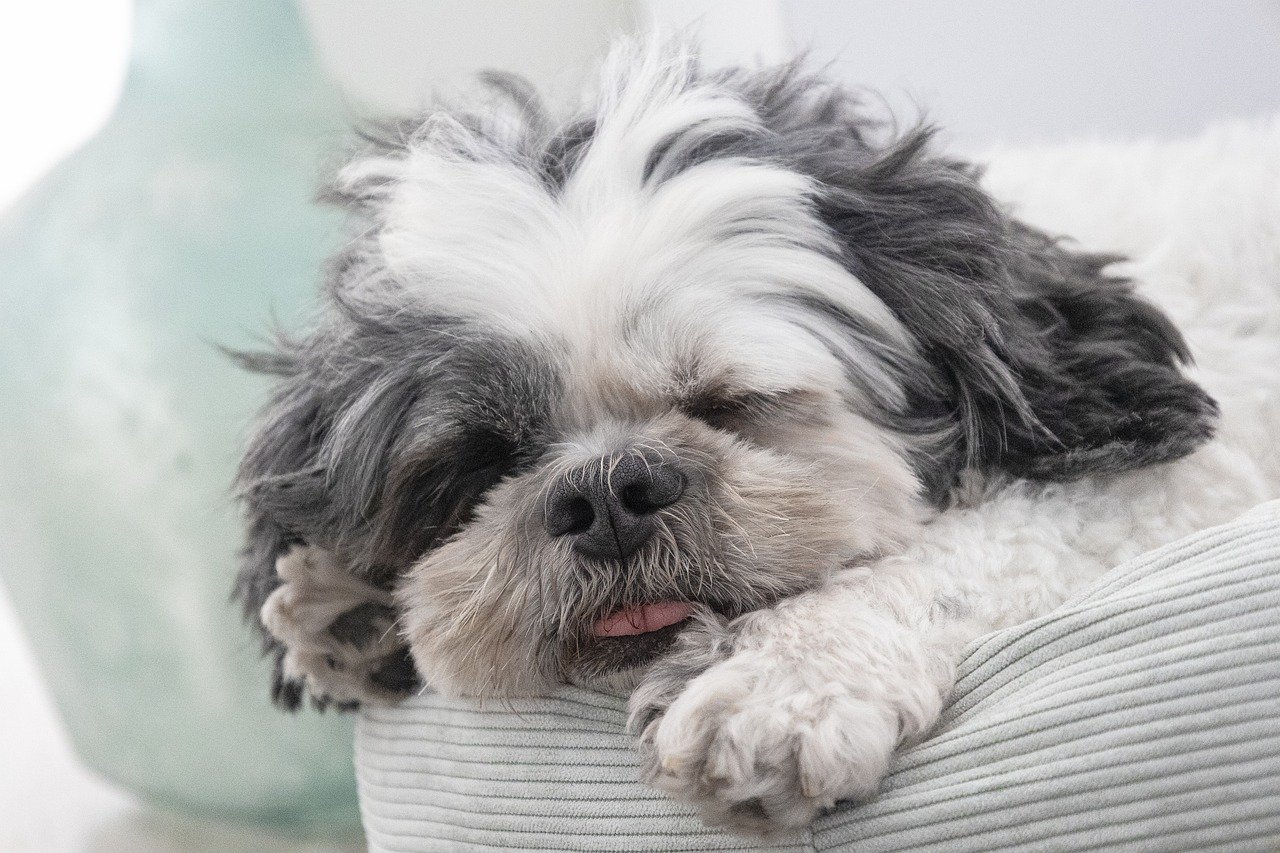
Preparing Your Pet for Travel
Traveling with your furry friend can be one of the most rewarding experiences, but it requires some careful preparation to ensure that your pet feels comfortable and secure. Just like us, pets can feel anxious about new environments and long journeys. So, how can you make the travel experience less stressful for your beloved companion? The key lies in acclimating your pet to the idea of travel well before the actual trip. Think of it like preparing for a big event; you wouldn’t just jump on stage without rehearsing, right? Similarly, your pet needs to get used to the idea of traveling.
One effective way to help your pet adjust is through practice runs. Start with short trips around your neighborhood or to a nearby park. This not only helps your pet get used to the car but also allows you to observe how they react to the motion and sounds associated with travel. Gradually increase the duration of these trips. For instance, if your first outing was just 15 minutes, try extending it to 30 minutes the next time. This gradual exposure can significantly reduce anxiety when it comes time for the longer journey.
Creating a comfortable space for your pet during travel is equally important. Imagine being in an unfamiliar place without any of your comforts; it can be quite unsettling! To ease this discomfort, bring along some familiar items such as your pet’s favorite blanket or toy. If your pet is crate-trained, use their crate as their travel space. Make sure it’s cozy and secure, perhaps adding a soft bed or familiar scents. This not only provides a sense of security but also helps them associate the crate with a safe haven, making the journey smoother.
Moreover, consider your pet's health when preparing for travel. If your pet has any special needs or medical conditions, consult your veterinarian for advice on how to manage these during your trip. They might suggest specific medications for anxiety or tips on how to care for your pet in unfamiliar settings. Remember, a well-prepared pet is a happy pet!
- How can I tell if my pet is anxious about traveling? Look for signs like excessive barking, whining, or trying to escape the crate. If your pet seems restless or is panting heavily, they may be feeling stressed.
- Should I feed my pet before traveling? It's usually best to avoid feeding your pet right before a trip. Instead, try to feed them a few hours prior to departure to reduce the risk of motion sickness.
- Can I use calming products for my pet during travel? Yes, there are various calming sprays, treats, and medications available that can help ease anxiety. Always consult your vet before trying new products.
- What should I do if my pet gets sick during travel? Always carry a pet first-aid kit. If your pet shows signs of severe distress or illness, pull over safely and consult your veterinarian as soon as possible.
Practice Runs
Taking your furry friend on a trip can be a thrilling adventure, but let’s face it—some pets need a little extra preparation to make the journey enjoyable for everyone involved. This is where come into play! Just like we wouldn’t jump into a marathon without training, our pets also benefit from getting accustomed to travel before the big day. Imagine how much more relaxed both you and your pet will feel if they’re already familiar with the car or the travel crate!
Start with short trips around your neighborhood or to a nearby park. These mini-adventures can help your pet get used to the sensation of being in a moving vehicle. During these practice runs, pay attention to how your pet reacts. Are they anxious, or do they seem excited? Understanding their behavior can provide insights into how they might handle longer journeys. If your pet appears stressed, don’t worry! It’s all part of the process. You can gradually increase the distance and duration of these trips, allowing your pet to adapt comfortably.
During these practice runs, it’s essential to create a positive environment. Bring along their favorite toys or a comfy blanket that smells like home. This familiar scent can be incredibly soothing and can help your pet associate car rides with good times. You might even want to pack some treats to reward them for their bravery! Think of it as a fun little adventure, rather than just a chore.
Here’s a quick checklist for your practice runs:
- Start with short distances and gradually increase.
- Bring familiar items to make your pet feel secure.
- Monitor their behavior and comfort level.
- Reward them with treats and praise for positive behavior.
Remember, the goal is to make travel a stress-free experience for both you and your pet. By incorporating these practice runs into your routine, you’re not only preparing them for the journey ahead but also strengthening your bond. After all, travel is about creating memories together, and you want those memories to be filled with joy, not anxiety!
Q: How long should my practice runs be?
A: Start with 10-15 minute trips and gradually increase the duration as your pet becomes more comfortable.
Q: What if my pet gets car sick?
A: If your pet shows signs of car sickness, consult your veterinarian for advice on how to manage it. You might need to take shorter trips and build up gradually.
Q: Should I feed my pet before a practice run?
A: It’s often best to avoid feeding your pet right before a trip to minimize the risk of car sickness. Instead, try feeding them a few hours before.
Creating a Comfortable Space
When it comes to traveling with your beloved pet, creating a comfortable space for them during the journey is absolutely essential. Think of it as setting up a little haven on the go, a cozy nook that makes them feel safe and secure, just like home. Start by choosing a suitable travel crate or carrier that’s the right size for your furry friend; it should be spacious enough for them to stand up, turn around, and lie down comfortably. A snug fit can help them feel more secure, while a space that's too large might make them feel anxious.
Next, consider adding some familiar items to their travel area. This could include their favorite blanket, a couple of toys, or even a piece of your clothing. The scent of these familiar items can have a calming effect, helping to ease any anxiety they might feel while on the road. Imagine how comforting it is to have a piece of home with you when you're in an unfamiliar place; pets feel the same way!
It's also important to maintain a consistent temperature in their travel space. If you're traveling by car, make sure the air conditioning is set to a comfortable level, especially on hot days. If it’s chilly outside, ensure your pet is warm enough, perhaps by using a cozy blanket. You wouldn’t want to be stuck in a freezing car, and neither does your pet!
During travel, frequent breaks are essential. Plan stops every couple of hours to let your pet stretch their legs, relieve themselves, and hydrate. This not only keeps them comfortable but also helps prevent restlessness. While you’re at it, keep an eye out for signs of discomfort or stress. If your pet seems restless or anxious, take a moment to reassure them and give them a little extra attention.
In summary, creating a comfortable space for your pet while traveling involves a mix of the right equipment, familiar items, and attention to their needs. By taking these steps, you can help ensure that your furry companion feels safe, secure, and happy on the road, making the journey enjoyable for both of you. So, pack those essentials, and get ready for an adventure filled with wagging tails and happy purrs!
- What should I pack for my pet when traveling?
It's essential to pack food, water, bowls, a leash, waste bags, grooming supplies, and any medications your pet may need. - How can I help my pet feel secure during travel?
Use familiar items like blankets and toys, and ensure they have a comfortable, secure space in the vehicle. - Are there any travel restrictions for pets?
Yes, some states and countries have specific regulations regarding pet travel, including vaccination requirements and quarantine rules. - How often should I take breaks during a long trip?
It's best to take breaks every 2-3 hours to allow your pet to stretch, relieve themselves, and hydrate.

Safety Tips for Traveling with Pets
Traveling with your beloved pet can be an exhilarating experience, but it also comes with its own set of challenges. To ensure a smooth journey, it’s essential to prioritize safety at every step. One of the first things to keep in mind is that your pet's safety in the vehicle is paramount. Always secure your furry friend using a crate or a pet seatbelt. This not only helps to prevent distractions while driving but also keeps your pet safe in case of sudden stops or accidents. Imagine the chaos that could ensue if your excited pup decides to jump into your lap while you're cruising down the highway! By taking these precautions, you can avoid such scenarios and focus on enjoying the ride.
Another critical aspect of pet travel safety is recognizing your pet's stress signals. Just like us, our pets can feel anxious when they’re in unfamiliar environments or situations. Common signs of stress can include excessive barking, panting, or even attempts to hide. If you notice any of these behaviors, it’s important to address your pet’s needs promptly. You might consider bringing along their favorite blanket or toy, as familiar items can provide comfort during travel. Additionally, taking breaks during long trips can give your pet a chance to stretch their legs and relieve any built-up anxiety.
When planning your travels, it’s also wise to familiarize yourself with local veterinary services along your route. In case of an emergency, knowing where to find help can be a lifesaver. Consider creating a small travel kit that includes not just your pet’s essentials but also a list of nearby veterinarians and emergency clinics. This way, you can travel with peace of mind, knowing that you’re prepared for any situation that may arise.
Lastly, it’s important to keep your pet hydrated and fed during your travels. Make sure to pack enough food and water for the trip, as well as portable bowls for easy access. If you're traveling by car, plan your stops to include opportunities for your pet to eat, drink, and relieve themselves. Remember, a well-hydrated and well-fed pet is a happy pet!
To summarize, here are some key safety tips to keep in mind while traveling with your pet:
- Secure your pet in the vehicle with a crate or seatbelt.
- Recognize and address stress signals promptly.
- Have a travel kit ready with essentials and local veterinary information.
- Ensure your pet stays hydrated and well-fed throughout the journey.
Q: What should I do if my pet gets car sick?
A: If your pet tends to get car sick, consult your veterinarian for advice. They may recommend medication or tips to help your pet feel more comfortable during travel.
Q: Can I take my pet on an airplane?
A: Yes, many airlines allow pets on board, but it’s crucial to check their specific policies and requirements. You may need a health certificate and a suitable travel carrier.
Q: How can I keep my pet calm during travel?
A: To keep your pet calm, try to create a familiar environment with their favorite items, take breaks for exercise, and consider using calming products or techniques recommended by your veterinarian.
Vehicle Safety
When it comes to traveling with your furry friend, is paramount. Just like you wouldn’t allow a toddler to roam freely in a moving car, your pet deserves the same level of protection. Think about it: a sudden stop or a sharp turn can be jarring, and you want to ensure your pet is secure and comfortable throughout the journey. So, what are some essential steps to take when it comes to keeping your pet safe in the vehicle?
First and foremost, always use a pet seatbelt or a secured crate. This not only keeps your pet from being a distraction while you drive but also protects them in the event of an accident. A well-ventilated crate can be a cozy haven for your pet, making them feel more secure during the ride. If you opt for a pet seatbelt, make sure it’s designed specifically for your pet’s size and weight. Remember, a one-size-fits-all approach doesn’t work when it comes to your pet’s safety!
Additionally, ensure that your pet is comfortable during the trip. Here are a few tips to consider:
- Take regular breaks during long trips to allow your pet to stretch their legs and relieve themselves.
- Keep the car at a comfortable temperature. Pets can easily overheat, especially if they are left unattended.
- Never leave your pet alone in the car, especially on hot days. Temperatures can rise rapidly, leading to heatstroke.
It’s also important to avoid letting your pet stick their head out of the window. While it may seem like a fun experience for them, it can be dangerous. Flying debris can injure their eyes, and sudden stops can cause them to lose their balance and fall out. Instead, keep the windows slightly cracked to allow fresh air in while keeping your pet safe.
Lastly, always have a pet first aid kit on hand. You never know when an emergency might arise, so being prepared can make a world of difference. Your kit should include items like bandages, antiseptic wipes, and any medications your pet may need. By taking these precautions, you can ensure that your travels are not only enjoyable but also safe for your beloved companion.
Q1: Can I let my pet roam freely in the car?
A1: It's not safe. Always secure your pet in a crate or use a pet seatbelt to prevent distractions and injuries.
Q2: What should I include in a pet first aid kit?
A2: Your kit should have bandages, antiseptic wipes, tweezers, and any medications your pet regularly takes.
Q3: How often should I take breaks during a long trip?
A3: Plan to take a break every 2-3 hours to allow your pet to stretch, hydrate, and relieve themselves.
Q4: Is it safe to leave my pet in the car for short periods?
A4: It's best to avoid leaving your pet in the car, even for short periods, especially in warm weather.
Recognizing Stress Signals
When traveling with your furry companion, it’s essential to be vigilant about their emotional state. Just like us, pets can experience stress, especially during the hustle and bustle of travel. Recognizing these stress signals can make a world of difference in ensuring a comfortable journey for both you and your pet. So, what should you look out for? Here are some common signs that your pet may be feeling anxious:
- Excessive Barking or Whining: If your pet suddenly becomes vocal, it might be their way of expressing discomfort or anxiety.
- Pacing: A restless pet may pace back and forth, indicating they are not at ease.
- Hiding: If your pet tries to find a safe space away from the action, it’s a sign they are overwhelmed.
- Drooling or Panting: Increased drooling or heavy panting can indicate stress, especially in situations where they feel trapped.
- Changes in Appetite: If your pet refuses to eat or drink, it could be a result of anxiety.
Recognizing these signals is just the first step. It's equally important to know how to respond. For instance, if your pet begins to whine or bark excessively, try to reassure them with a calm voice. Sometimes, a familiar toy or blanket can provide comfort and help them feel more secure. Additionally, making frequent stops during long drives can give your pet a chance to stretch and relieve themselves, which may alleviate some of their stress.
Another effective way to help your pet cope with travel anxiety is to create a calm environment. If you're traveling by car, consider playing soft music or using calming sprays designed for pets. These small adjustments can significantly reduce stress levels and create a more pleasant journey. Remember, your pet looks to you for guidance; if you remain calm and collected, they are more likely to feel the same way.
In conclusion, being attentive to your pet's stress signals and responding appropriately can transform a potentially overwhelming travel experience into a positive one. By taking the time to understand your pet's needs and emotions, you can ensure that both of you enjoy the journey ahead!
Q: How can I tell if my pet is stressed while traveling?
A: Look for signs such as excessive barking, pacing, drooling, or hiding. Changes in appetite can also be an indicator of stress.
Q: What should I do if my pet shows signs of anxiety during travel?
A: Reassure your pet with a calm voice, provide familiar items like toys or blankets, and make frequent stops to help them relieve stress.
Q: Are there any products that can help with pet travel anxiety?
A: Yes, consider using calming sprays, anxiety wraps, or even consult your veterinarian for recommendations on calming supplements.
Q: Can I train my pet to be more comfortable with traveling?
A: Absolutely! Gradual exposure to travel through short trips can help your pet acclimate and reduce anxiety over time.

Finding Pet-Friendly Accommodations
When it comes to traveling with your furry companions, finding the right place to stay can make or break your trip. Not all accommodations are created equal, and some are far more welcoming to pets than others. So, how do you ensure that both you and your pet are comfortable during your travels? First and foremost, it’s essential to do your homework. Researching pet-friendly hotels, motels, or vacation rentals is crucial. You want to find a place that not only allows pets but also caters to their needs. Here are a few tips to help you navigate the world of pet-friendly accommodations.
Before making any reservations, it's wise to check the pet policies of your chosen accommodation. Some places may have specific rules regarding pet sizes, breeds, or even the number of pets allowed. For example, many hotels may only allow dogs under a certain weight, while others might have a strict no-cats policy. Understanding these guidelines can save you a lot of hassle and disappointment upon arrival.
Once you have a shortlist of potential places, it’s time to dig a little deeper. Look for reviews from other pet owners. Websites like TripAdvisor or Yelp can provide valuable insights into how accommodating a hotel truly is. Pay attention to comments about pet amenities, such as dog parks, walking areas, or even pet-sitting services. These little perks can enhance your stay and make your pet feel right at home.
When you’re ready to make a reservation, don’t forget to inform the hotel about your pet. This simple step ensures that the staff is prepared for your arrival and can provide you with any necessary information, such as designated pet areas or nearby pet-friendly attractions. Additionally, some hotels may offer special packages or services for guests traveling with pets, so it’s worth asking!
Lastly, consider using online platforms dedicated to pet-friendly travel. Websites and apps like BringFido or PetFriendly can help you find accommodations that suit your needs. They often provide filters to search for pet amenities, making your life a whole lot easier. Remember, the goal is to have a memorable trip where both you and your pet can relax and enjoy the adventure together!
- What should I look for in a pet-friendly hotel? Look for accommodations that offer pet amenities like dog parks, pet-friendly rooms, and nearby walking trails.
- Are there additional fees for bringing my pet? Many hotels charge a pet fee, so always check the policy before booking.
- Can I leave my pet alone in the room? This varies by hotel; some may allow it, while others may require pets to be crated or not left alone at all.
- Is there a weight limit for pets at hotels? Yes, many hotels impose weight limits, so it's essential to verify this in advance.
Researching Pet Policies
When planning a trip with your furry friend, one of the most critical steps is at your chosen accommodations. Not all hotels, motels, or rental properties are created equal when it comes to welcoming pets. Some may have strict size or breed restrictions, while others might charge additional fees or require specific documentation. To avoid any surprises upon arrival, it’s essential to do your homework ahead of time.
Start by visiting the official website of the accommodation. Most hotels will have a dedicated section outlining their pet policies. Look for details such as:
- Pet Size and Breed Restrictions: Some places only allow small dogs or certain breeds, so it’s crucial to confirm this before booking.
- Fees and Deposits: Many pet-friendly hotels charge a non-refundable cleaning fee or a refundable deposit. Knowing this can help you budget accordingly.
- Designated Pet Areas: Some accommodations might have specific areas for pets to relieve themselves or play. Understanding these locations can enhance your pet’s experience.
- Rules and Regulations: Familiarize yourself with any rules such as leash requirements, noise restrictions, or whether pets are allowed in common areas.
Once you've gathered this information, it’s a good idea to call the hotel directly. Speaking to a staff member can provide clarity on any questions you might have and ensure that you have the most current information. This can also be an opportunity to inform them of your pet’s size and breed, which may not be listed online. If you’re traveling with multiple pets, be sure to mention this as well, as some places have limits on the number of animals allowed per room.
Moreover, it’s worth checking reviews from other pet owners who have stayed at the same accommodation. Websites like TripAdvisor or Yelp often feature feedback that can give you insight into how pet-friendly the hotel truly is. Look for comments about the staff’s attitude towards pets, the cleanliness of pet-friendly rooms, and any additional amenities offered, such as pet beds or bowls.
Lastly, if you find a place that seems perfect for you and your pet, consider making your reservation as soon as possible. Pet-friendly accommodations can fill up quickly, especially during peak travel seasons. By securing your spot early, you can ensure a smooth and enjoyable experience for both you and your furry companion.
Here are some common questions pet owners have when researching pet policies:
- What should I do if my pet has special needs? Always inform the hotel in advance so they can accommodate your pet's requirements.
- Can I leave my pet alone in the room? Many hotels have policies against leaving pets unattended, so check their rules.
- Are there additional charges for multiple pets? Yes, some places charge extra for each pet, so confirm this during your research.
- What happens if my pet damages something in the room? You may be responsible for damages, so it’s wise to ask about their policy on this matter.
Making Reservations
When it comes to booking a place for you and your furry friend, communication is key. It’s essential to inform the hotel or accommodation about your pet's presence at the time of making the reservation. This simple step can save you from potential headaches later on. Imagine arriving at a hotel only to find out they have a strict no-pet policy or that they’re fully booked for pet-friendly rooms! By being upfront, you ensure a smoother check-in process and that the staff is prepared to welcome you and your pet.
Before you hit that confirm button, here are a few things to keep in mind:
- Check Pet Policies: Different places have varying rules regarding pets. Some might charge additional fees, while others may have restrictions on the size or breed of pets allowed. Always read the fine print!
- Inform About Your Pet's Needs: If your pet has specific requirements, such as dietary restrictions or needs for special accommodations, let the hotel know in advance. This helps them ensure a comfortable stay for your pet.
- Ask About Amenities: Some pet-friendly hotels offer amenities like pet beds, bowls, or even pet-sitting services. Knowing what's available can enhance your experience and make your pet feel more at home.
Additionally, it’s a good idea to keep a list of pet-friendly accommodations handy. You can create a simple table to compare different options based on their pet policies, fees, and available amenities. Here’s an example:
| Hotel Name | Pet Fee | Size Restrictions | Amenities |
|---|---|---|---|
| Happy Paws Inn | $25/night | Up to 50 lbs | Pet bed, bowls |
| Furry Friends Hotel | $15/night | No restrictions | Pet sitting, treats |
| Pet Paradise Resort | $30/night | Up to 70 lbs | Dog park access, grooming services |
By being proactive and thorough in your reservation process, you’re setting the stage for a fantastic getaway with your pet. After all, the journey is just as important as the destination, and ensuring your pet is comfortable will make all the difference in creating unforgettable memories together.
Q: What should I do if my pet has special needs?
A: Always inform the hotel about your pet's specific requirements when making reservations. This way, they can accommodate your needs more effectively.
Q: Are all hotels pet-friendly?
A: No, not all hotels allow pets. It’s crucial to research and confirm pet policies before booking your stay.
Q: Is there usually an extra fee for pets?
A: Many pet-friendly accommodations charge a fee, which can vary widely. Always check the pet policy for any additional costs.
Q: Can I leave my pet alone in the room?
A: This varies by hotel. Some may allow it, while others may have restrictions. Always check with the hotel staff for their policy.
Frequently Asked Questions
- What should I include in my pet travel checklist?
Your pet travel checklist should include essential items such as vaccination records, health certificates, identification tags, food, water, travel bowls, a leash, and a comfy crate or carrier. Don’t forget to pack familiar toys and blankets to help your pet feel at home during the journey!
- How can I prepare my pet for a long trip?
To prepare your pet for a long trip, start with short practice runs in the car. Gradually increase the duration of these trips to help your pet adjust. Make their travel space cozy by including their favorite blanket or toy, and ensure they have plenty of breaks during longer journeys.
- Are there specific health documents required for traveling with pets?
Yes! Depending on your destination, you may need a health certificate from your veterinarian, especially for air travel or crossing state lines. Keeping your pet’s vaccination records updated is also crucial as some places may require proof of vaccinations.
- How can I ensure my pet's safety during travel?
To ensure your pet's safety, always secure them in a crate or with a pet seatbelt while driving. This prevents distractions and protects them in case of sudden stops. Additionally, monitor your pet for signs of stress and take breaks to let them stretch and relieve themselves.
- What should I look for in pet-friendly accommodations?
When searching for pet-friendly accommodations, check their pet policies for size restrictions, fees, and any specific rules. It's also helpful to read reviews from other pet owners to ensure a welcoming environment for your furry friend.
- How do I handle my pet's anxiety during travel?
Recognizing your pet's stress signals is key. Common signs include panting, whining, or pacing. To soothe your pet, talk to them in a calm voice, offer treats, and take breaks to allow them to relax. Familiar items like blankets or toys can also provide comfort.

